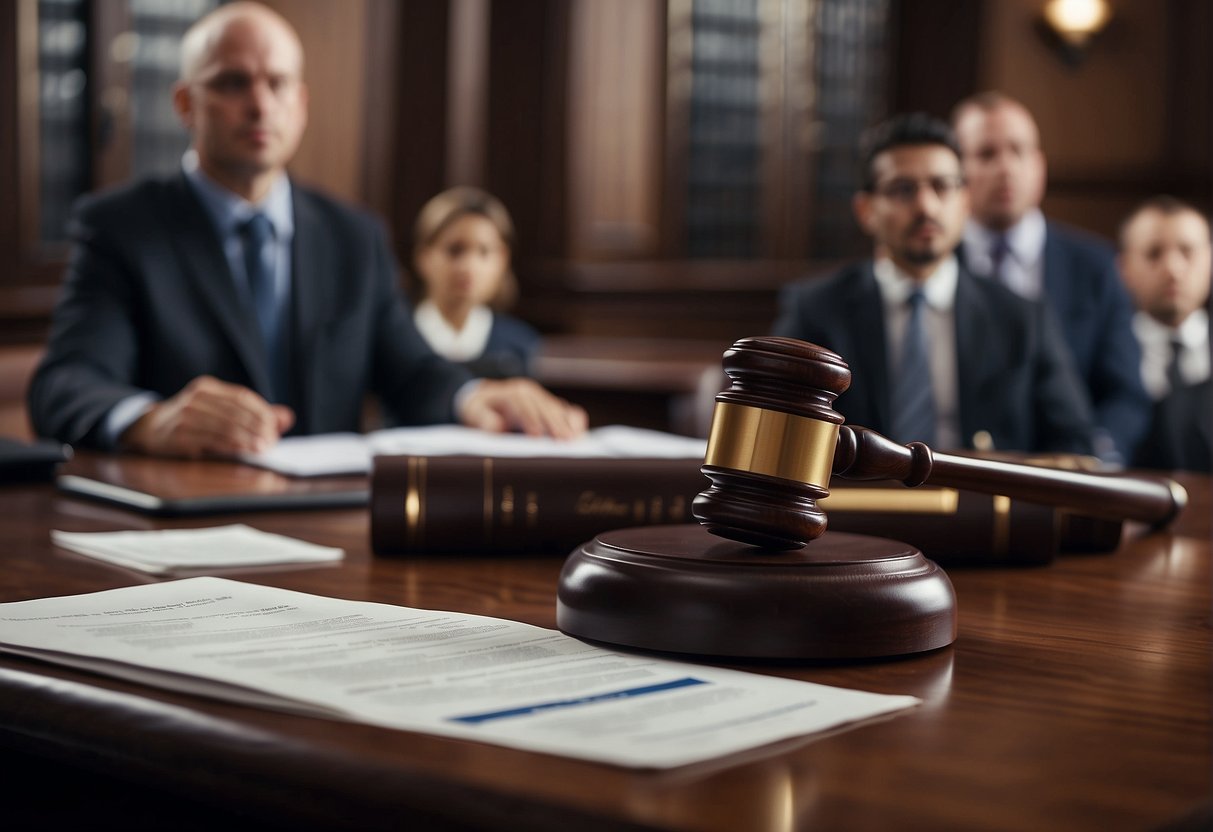Understanding Personal Injury Law

Personal injury law encompasses the legal defenses and remedies involved in civil lawsuits brought as a result of wrongful conduct. At its heart, it’s about holding parties legally responsible for causing harm.
The Foundation of Personal Injury Claims
Personal injury law operates on the principle that a person who suffers harm due to another’s action or inaction should be compensated. The foundation is built on two concepts: duty of care and breach of duty. Every individual has a duty to act in a way that does not inflict injury upon others. When this duty is breached, it lays the groundwork for a personal injury claim.
- Duty of Care: A legal obligation requiring adherence to a standard of reasonable care.
- Breach of Duty: A violation of the duty of care, either by action or omission.
Duty of Care and Breach
We must understand duty of care and breach to grasp personal injury law’s complexities. Individuals and entities have a legal obligation to avoid acts or omissions that could foreseeably harm others.
- Plaintiff: The injured party who is bringing the lawsuit.
- Defendant: The party alleged to have breached the duty of care.
| Criteria | Description |
|---|---|
| Duty of Care | Obligation to prevent harm |
| Breach | Failure to uphold this duty |
| Causation | Link between the breach and injury |
| Damages | Actual harm suffered by the plaintiff |
Determining Liability and Negligence
In the realm of personal injury law, liability is established by demonstrating negligence. This entails showing that the defendant acted negligently, resulting in the plaintiff’s injuries.
- Negligence: The failure to exercise the care that a reasonably prudent person would under similar circumstances.
- Liability: The legal responsibility for one’s actions or inactions.
To prove negligence, the plaintiff must establish several elements:
- Duty: The defendant owed a duty of care to the plaintiff.
- Breach: The defendant breached that duty.
- Causation: The breach directly caused the injuries.
- Damages: The plaintiff suffered actual harm.
The above are pivotal in determining the compensation for personal injury claims.
The Evidence in Personal Injury Cases
We understand that the strength of a personal injury case often hinges on the evidence presented. This evidence must clearly establish the extent of injuries, liability, and the impact of the injury on the claimant’s life.
Role and Importance of Evidence
The evidence in personal injury cases functions as the foundation upon which claims are built and adjudicated. It is vital, as it substantiates the claims of injury, helps establish fault, and directly influences the compensation awarded. The presence and quality of evidence can make the difference between a successful claim and an unsuccessful one.
Types of Evidence
In personal injury claims, various types of evidence are used:
- Medical records: These provide a detailed account of the injuries sustained and treatments required, forming the crux of the claim.
- Photographs and video: Visual evidence from the accident scene and injuries offer indisputable facts about the circumstances and severity of the incident.
- Witness testimony: Statements from individuals who saw the event can bolster a claim by adding credibility to the presented narrative.
- Expert testimonies: Testimonies from medical professionals or accident reconstruction experts help in interpreting the evidence and establishing the relationship between the accident and the injuries suffered.
- Police reports: Often serve as an impartial account of the accident, providing details that can be critical to determining liability.
- Physical evidence: Includes any material object from the accident scene that can provide insights into the cause and impact of the incident.
Evidence Collection and Preservation
For us, ensuring the proper collection and preservation of evidence is crucial:
- Immediate evidence collection: At the accident scene, it’s essential to gather evidence promptly to avoid loss or deterioration. This involves taking photographs, videos, and collecting physical evidence.
- Securing documentation: Gathering all relevant documentation like medical records, accident reports, and employment records is necessary to support the claim.
- Preserving witness statements: Capturing witness accounts as soon as possible after the incident is important to ensure the accuracy and reliability of their recollection.
- Engaging expert witnesses: Early consultation with experts can help in effective evidence presentation later in the claims process.
Employing meticulous attention to the evidence not only clarifies the narrative of the incident but also reinforces the legitimacy of personal injury claims.
Assessing Damages and Compensation

In personal injury claims, we meticulously evaluate the extent of damages and determine fair compensation, accounting for both concrete financial losses and intangible impacts on the claimant’s life.
Evaluating Economic and Non-Economic Damages
Economic damages are quantifiable financial losses that stem from the injury. These usually include:
- Medical Expenses: Costs of treatment, rehabilitation, and medication.
- Lost Wages: Income lost due to inability to work.
Non-economic damages, on the other hand, are intangible and not as easily quantified. They primarily involve:
- Pain and Suffering: Physical and emotional distress.
- Quality of Life: Losses in life enjoyment and capability.
To ensure fairness, we carefully document all pertinent aspects of these damages.
Calculating Compensation for Injuries
The process of calculating monetary compensation involves a detailed analysis of the economic and non-economic damages. We use different methods for computation, such as:
- Multipliers for pain and suffering based on the severity of the injury.
- Projections of future lost earnings and medical care.
It’s vital to be as accurate as possible to cover all associated financial damages.
The Role of Expert Witnesses in Valuation
Expert witnesses play a critical role in articulating the value of damages. Their inputs help in:
- Clarifying medical costs and the impact of injuries on one’s health.
- Testifying on occupational aspects and how injuries affect earning capacity.
Their objective assessments aid in negotiations with insurance companies, ensuring that compensation is grounded in factual evidence.
The dedication to assessing damages and compensation meticulously is fundamental for achieving just restitution for personal injury victims. Through systematic evaluation and precise calculations, we strive to ensure that every claimant receives the full range of compensation they are due.
Legal Proceedings in Personal Injury Claims

In personal injury claims, legal proceedings play a critical role in resolving disputes and determining fair compensation. We navigate multiple phases, from pre-trial negotiations to the intricacies of trial, all while contending with the interests of insurance companies.
Pre-Trial Process and Settlement Negotiations
Before a trial commences, we engage extensively in the pre-trial process. Our initial steps often involve:
- Gathering Evidence: This includes medical records, witness statements, and accident reports to build a solid case.
- Legal Pleadings: We draft and file complaints and other legal documents to formally start the legal action.
Throughout these stages, settlement negotiations can occur at any time. Insurance companies typically prefer to settle claims out of court to avoid the costs of a trial. We aim to negotiate the best possible outcome for our clients, which involves:
- Demand Letters: A formal request for compensation.
- Mediation: A neutral third party helps facilitate negotiations.
- Settlement Offers: Evaluating and advising on offers received from the insurance company.
Trial and Presentation of Evidence
If negotiations don’t lead to a settlement, the case goes to trial. Here, our representation is crucial for:
- Opening Statements: Outlining the case to the jury.
- Witness Testimony: Calling on witnesses to corroborate the claim.
- Evidence Presentation: Demonstrating liability and damages through exhibits and expert testimony.
- Closing Arguments: Summarizing the case and urging the jury to deliver a favorable verdict.
A well-presented argument is key in persuading the jury and judge.
Insurance Company’s Role and Challenges
Insurance companies are deeply involved in the personal injury legal proceedings. Their main interests lie in:
- Minimizing Payouts: To limit financial losses.
- Disputing Claims: Often challenging the extent of injuries or fault.
As personal injury lawyers, we actively counter these tactics by:
- Asserting the Claim: Ensuring all relevant facts and laws support our client’s position.
- Challenging Low Offers: Negotiating vigorously against inadequate settlement proposals.
Understanding the nuances of how insurance companies operate enables us to better advocate for our clients’ interests.
Strategies for a Successful Personal Injury Claim
We understand that building a strong personal injury claim hinges largely on the effective management of evidence, strategic legal guidance, and the utilization of expertise to maximize claim value.
Effective Evidence Management
To ensure successful recovery of damages, we prioritize initial investigation to ascertain all aspects of the personal injury case. This entails:
- Gathering pertinent evidence such as medical records, accident reports, and witness statements.
- Documenting injuries and treatment comprehensively to establish causation and the extent of harm.
- Organizing evidence systematically to support the burden of proof, enhance reliability, and streamline case presentation.
The Importance of Legal Guidance
Navigating personal injury law requires skilled attorneys who offer:
- Strategic advice during litigation or settlement negotiations to champion our interests.
- Interpretation of complex legal terms and proceedings to keep us informed and prepared.
- Legal assistance in filing claims timely and effectively, adhering to statutory requirements and court deadlines.
Maximizing Claim Value Through Expertise
To quantify damages and validate claims, we engage with expert testimony. Experts can:
- Corroborate the link between the injury and the incident, underlining causation.
- Assess the long-term impact of injuries, contributing to a fair valuation of the claim.
- Provide specialized knowledge helping to clarify technical aspects and reinforcing the integrity of our claims.
By meticulously managing evidence, leveraging legal guidance, and utilizing expertise, we equip our personal injury claims with the foundational strength they require for favorable outcomes.
Frequently Asked Questions
In personal injury cases, evidence is crucial for substantiating claims and determining fair compensation. We explore common inquiries relating to the types and roles of proof needed within such legal matters.
What constitutes sufficient proof of injury in a personal injury lawsuit?
Sufficient proof of injury typically involves medical records, expert testimony, and photographic evidence of the injury. We ensure these elements demonstrate the injury’s nature, extent, and impact on the claimant’s life.
How do liability and damages get established in a negligence claim?
To establish liability in a negligence claim, we must prove that the defendant had a duty of care, breached this duty, and caused the claimant’s injuries as a result. Damages are then assessed based on the extent of the injuries, lost earnings, and additional losses.
What types of documentation are critical for substantiating a personal injury claim?
Critical documentation includes medical records, bills, proof of income loss, and any repair bills. This paperwork acts as the foundation for calculating economic damages.
How are pain and suffering evaluated and quantified in personal injury cases?
Pain and suffering are quantified using methods like multipliers of actual damages or per diem approaches. We consider the injury severity, recovery time, and daily impact on the claimant’s life when evaluating these non-economic damages.
In the context of personal injury claims, how does one demonstrate causation?
Demonstrating causation involves showing a clear link between the defendant’s breach of duty and the claimant’s injuries. This may require evidence like accident reconstruction, expert testimony, and consistent medical documentation post-injury.
What role does medical evidence play in establishing the extent of injury for compensation?
Medical evidence is pivotal to our process as it establishes the extent of injuries, the required treatments, recovery trajectory, and any long-term effects. This evidence helps in accurately calculating compensatory damages.




